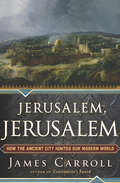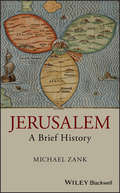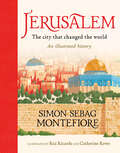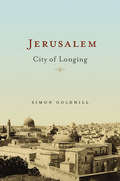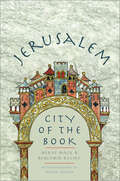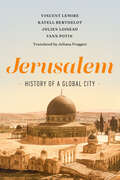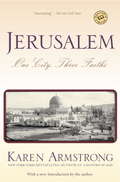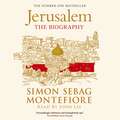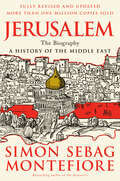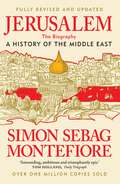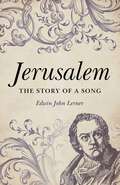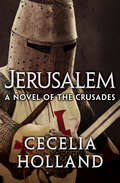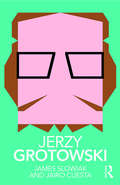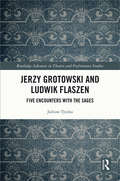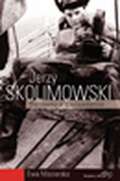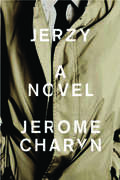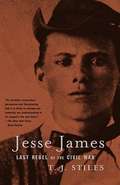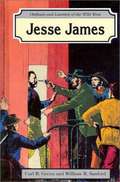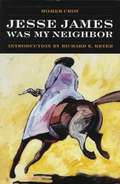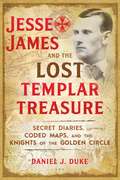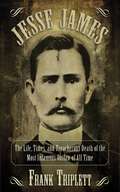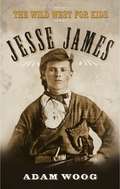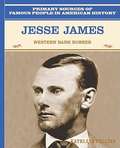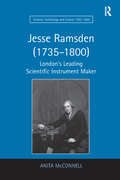- Table View
- List View
Jerusalem, Jerusalem: How the Ancient City Ignited Our Modern World
by James CarrollA &“masterful&” history of the city and its holy wars past and present, from the New York Times–bestselling author of Constantine&’s Sword (The Boston Globe). How did this ancient Middle Eastern city become a transcendent fantasy that ignites religious fervor unlike anywhere else on earth? Jerusalem, Jerusalem journeys through centuries of conflict among Jews, Christians, and Muslims, right up to the present-day Israeli-Palestinian struggle—with fascinating examinations of how the idea of the holy city has shaped not just the region&’s history but the world&’s.
Jerusalem: A Brief History (Wiley Blackwell Brief Histories of Religion)
by Michael ZankJerusalem - A Brief History shows how Jewish, Christian, and Islamic scriptures confer providential meaning to the fate of the city and how modern Jerusalem is haunted by waves of biblical fantasy aiming at mutually exclusive status-quo rectification. It presents the major epochs of the history of Jerusalem’s urban transformation, inviting readers to imagine Jerusalem as a city that is not just sacred to the many groups of people who hold it dear, but as a united, unharmed place that is, in this sense, holy. <p><p> Jerusalem - A Brief History starts in modern Jerusalem—giving readers a look at the city as it exists today. It goes on to tell of its emergence as a holy city in three different ways, focusing each time on another aspect of the biblical past. Next, it discusses the transformation of Jerusalem from a formerly Jewish temple city, condemned to oblivion by its Roman destroyers, into an imperially sponsored Christian theme park, and the afterlife of that same city under later Byzantine and Muslim rulers. Lastly, the book returns to present day Jerusalem to examine the development of the modern city under the Ottomans and the British, the history of division and reunification, and the ongoing jostling over access to, and sovereignty over, Jerusalem’s contested holy places.
Jerusalem: An Illustrated History
by Simon Sebag MontefioreJerusalem is unique: the capital of two peoples and the shrine of three faiths. A cast of extraordinary characters have played a part in the city's history, including King David, Cyrus the Great, Cleopatra, the Maccabees, Julius Caesar, Herod the Great, Queen Melisende, Saladin, Suleiman the Magnificent, Catherine the Great, Napoleon, Churchill, Ben-Gurion and Arafat.Many have claimed Jerusalem belongs only to them, but its stories belong to many. In this beautifully illustrated book, historian Simon Sebag Montefiore tells thirty of the most remarkable stories in the city's 3,000-year history. By explaining the Middle East's political, religious and ethnic divisions, from 1000 BCE to 2000, the book becomes an essential guide to understanding today's world.Based on the seminal classic Jerusalem: A Biography, and vividly brought to life by illustrators Rui Ricardo and Catherine Rowe.
Jerusalem: City of Longing (Wonders Of The World Ser. #21)
by Simon GoldhillJerusalem is the site of some of the most famous religious monuments in the world, from the Dome of the Rock to the Church of the Holy Sepulchre to the Western Wall of the Temple. Since the nineteenth century, the city has been a premier tourist destination, not least because of the countless religious pilgrims from the three Abrahamic faiths. But Jerusalem is more than a tourist site—it is a city where every square mile is layered with historical significance, religious intensity, and extraordinary stories. It is a city rebuilt by each ruling Empire in its own way: the Jews, the Romans, the Christians, the Muslims, and for the past sixty years, the modern Israelis. What makes Jerusalem so unique is the heady mix, in one place, of centuries of passion and scandal, kingdom-threatening wars and petty squabbles, architectural magnificence and bizarre relics, spiritual longing and political cruelty. It is a history marked by three great forces: religion, war, and monumentality. In this book, Simon Goldhill takes on this peculiar archaeology of human imagination, hope, and disaster to provide a tour through the history of this most image-filled and ideology-laden city—from the bedrock of the Old City to the towering roofs of the Holy Sepulchre. Along the way, we discover through layers of buried and exposed memories—the long history, the forgotten stories, and the lesser-known aspects of contemporary politics that continue to make Jerusalem one of the most embattled cities in the world.
Jerusalem: City of the Book
by Benjamin Balint Merav MackA captivating journey through the hidden libraries of Jerusalem, where some of the world’s most enduring ideas were put into words In this enthralling book, Merav Mack and Benjamin Balint explore Jerusalem’s libraries to tell the story of this city as a place where some of the world’s most enduring ideas were put into words. The writers of Jerusalem, although renowned the world over, are not usually thought of as a distinct school; their stories as Jerusalemites have never before been woven into a single narrative. Nor have the stories of the custodians, past and present, who safeguard Jerusalem’s literary legacies. By showing how Jerusalem has been imagined by its writers and shelved by its librarians, Mack and Balint tell the untold history of how the peoples of the book have populated the city with texts. In their hands, Jerusalem itself—perched between East and West, antiquity and modernity, violence and piety—comes alive as a kind of labyrinthine library.
Jerusalem: History of a Global City
by Vincent LemireAn expansive history of Jerusalem as a cultural crossroads, and a fresh look at the urban development of one of the world's most mythologized cities. Jerusalem is often seen as an eternal battlefield in the "clash of civilizations" and in endless, inevitable wars of religion. But if we abandon this limiting image when reviewing the entirety of its concrete urban history—from its beginnings to today—we discover a global city at the world's crossroads. Jerusalem is the common cradle of Judaism, Christianity, and Islam, whose long and intertwined pasts include as much exchange and reciprocal influence as conflict and confrontation. This synthetic account is the first to make available to the general public Jerusalem's whole history, informed by the latest archaeological finds, unexplored archives, and ongoing research and offering a completely renewed understanding of the city's past and geography. This book is an indispensable guide to understanding why the world converges on Jerusalem.
Jerusalem: One City, Three Faiths
by Karen ArmstrongBONUS: This edition contains an excerpt from Karen Armstrong's Twelve Steps to a Compassionate Life.Venerated for millennia by three faiths, torn by irreconcilable conflict, conquered, rebuilt, and mourned for again and again, Jerusalem is a sacred city whose very sacredness has engendered terrible tragedy. In this fascinating volume, Karen Armstrong, author of the highly praised A History of God, traces the history of how Jews, Christians, and Muslims have all laid claim to Jerusalem as their holy place, and how three radically different concepts of holiness have shaped and scarred the city for thousands of years.Armstrong unfolds a complex story of spiritual upheaval and political transformation--from King David's capital to an administrative outpost of the Roman Empire, from the cosmopolitan city sanctified by Christ to the spiritual center conquered and glorified by Muslims, from the gleaming prize of European Crusaders to the bullet-ridden symbol of the present-day Arab-Israeli conflict. Written with grace and clarity, the product of years of meticulous research, Jerusalem combines the pageant of history with the profundity of searching spiritual analysis. Like Karen Armstrong's A History of God, Jerusalem is a book for the ages.
Jerusalem: The Biography
by Simon Sebag MontefioreJerusalem is the universal city, the capital of two peoples, the shrine of three faiths; it is the prize of empires, the site of Judgement Day and the battlefield of today's clash of civilizations. From King David to Barack Obama, from the birth of Judaism, Christianity and Islam to the Israel-Palestine conflict, this is the epic history of 3,000 years of faith, slaughter, fanaticism and coexistence.How did this small, remote town become the Holy City, the 'centre of the world' and now the key to peace in the Middle East? In a gripping narrative, Simon Sebag Montefiore reveals this ever-changing city in its many incarnations, bringing every epoch and character blazingly to life. Jerusalem's biography is told through the wars, love affairs and revelations of the men and women - kings, empresses, prophets, poets, saints, conquerors and whores - who created, destroyed, chronicled and believed in Jerusalem.Drawing on new archives, current scholarship, his own family papers and a lifetime's study, Montefiore illuminates the essence of sanctity and mysticism, identity and empire in a unique chronicle of the city that many believe will be the setting for the Apocalypse. This is how Jerusalem became Jerusalem, and the only city that exists twice - in heaven and on earth.Read by John Lee(p) 2011 Penguin Random House LLC
Jerusalem: The Biography
by Simon Sebag MontefioreThe epic history of three thousand years of faith, fanaticism, bloodshed, and coexistence, from King David to the 21st century, from the birth of Judaism, Christianity, and Islam to the Israel-Palestine conflict, from the bestselling author of The Romanovs • "Impossible to put down…. Vastly enjoyable." —The New York Times Book Review How did this small, remote town become the Holy City, the &“center of the world&” and now the key to peace in the Middle East? In a gripping narrative, Simon Sebag Montefiore reveals this ever-changing city in its many incarnations, bringing every epoch and character blazingly to life. Jerusalem&’s biography is told through the wars, love affairs, and revelations of the men and women who created, destroyed, chronicled and believed in Jerusalem. As well as the many ordinary Jerusalemites who have left their mark on the city, its cast varies from Solomon, Saladin and Suleiman the Magnificent to Cleopatra, Caligula and Churchill; from Abraham to Jesus and Muhammad; from the ancient world of Jezebel, Nebuchadnezzar, Herod and Nero to the modern times of the Kaiser, Disraeli, Mark Twain, Lincoln, Rasputin, Lawrence of Arabia and Moshe Dayan. In this masterful narrative, Simon Sebag Montefiore brings the holy city to life and draws on the latest scholarship, his own family history, and a lifetime of study to show that the story of Jerusalem is truly the story of the world.
Jerusalem: The Biography – A History of the Middle East
by Simon Sebag MontefioreThoroughly updated and revised for 2024, JERUSALEM: THE BIOGRAPHY is the history of the Middle East through the lens of the Holy City and the Holy Land, from King David to the wars and chaos of today. The history of Jerusalem is the story of the world: Jerusalem is the universal city, the capital of two peoples, the shrine of three faiths. The Holy City and Holy Land are the battlefields for today's multifaceted conflicts and, for believers, the setting for Judgement Day and the Apocalypse.How did this small, remote town become the Holy City, the 'centre of the world' and now the key to peace in the Middle East? Why is the Holy Land so important not just to the region and its many new players, but to the wider world too? Drawing on new archives and a lifetime's study, Montefiore reveals this ever-changing city and turbulent region through the wars, love affairs and revelations of the kings, empresses, amirs, sultans, caliphs, presidents, autocrats, imperialists and warlords, poets, prophets, saints and rabbis, conquerors and whores who created, destroyed, chronicled, and believed in Jerusalem and the Holy Land. A classic of modern literature, this is not only the epic story of 3,000 years of faith, slaughter, fanaticism, co-existence, power and myth, but also a freshly updated, carefully balanced history of the Middle East, from King David to the new players and powers of the twenty-first century, from the birth of Judaism, Christianity and Islam to the Israel-Palestine conflict and the mayhem of today.This is how today's Middle East was forged, how the Holy Land became sacred and how Jerusalem became Jerusalem - the only city that exists twice - in heaven and on earth.
Jerusalem: The Story of a Song
by Edwin John LernerJerusalem: The Story of a Song is a popular history of England's unofficial national anthem, which began life as a poem by William Blake, was set to music by Hubert Parry and is sung every year at the Last Night of the Proms.
Jerusalem: Until The Sun Falls, Jerusalem, And Pillar Of The Sky
by Cecelia HollandNon nobis, Domine, non nobis, sed Nomine Tuo da gloriam. "Not to us, O Lord, but to Your Name give glory." This motto highlights the vows of chastity and humility taken by the Knights Templar. But, it also speaks to their role as ferocious warriors, passionately and bloodily seeking out glory for their God.Set in the Holy Land in 1187 A.D., Cecelia Holland's historical novel masterfully explores the conspiracies and political maneuvers leading up to the Third Crusade. Following a stunning victory at the Battle of Ramleh, Norman Templar Rannulf Fitzwilliam must negotiate a truce with the enemy and determine the order of succession to the throne of Baudouin, the young Christian king dying of leprosy. However, Rannulf's instincts are for battle, not diplomacy. Temptation and betrayal await him around every corner. The question is not whether he can survive on the battlefield, but whether he can survive the politics and protocol of the royal court."Holland's masterful layering of subplots, historical detail and multiple perspectives makes for a great read." --Publisher's Weekly"She brings as much suspense to political intrigue as to the sprawling battle scenes at which she excels." --The New York Times Book Review
Jerzy Grotowski (Routledge Performance Practitioners)
by James Slowiak Jairo CuestaMaster director, teacher, and theorist, Jerzy Grotowski’s work extended well beyond the conventional limits of performance. Now revised and reissued, this book combines: ● an overview of Grotowski’s life and the distinct phases of his work ● an analysis of his key ideas ● a consideration of his role as director of the renowned Polish Laboratory Theatre ● a series of practical exercises offering an introduction to the principles underlying Grotowski’s working methods. As a first step towards critical understanding, and an initial exploration before going on to further, primary research, Routledge Performance Practitioners offer unbeatable value for today’s student.
Jerzy Grotowski and Ludwik Flaszen: Five Encounters with the Sages (Routledge Advances in Theatre & Performance Studies)
by Juliusz TyszkaThe book contains three accounts of five public speeches and conversations with the public of two outstanding figures of theatre and performance, Jerzy Grotowski and Ludwik Flaszen, from 1993 to 1997. Their speeches concern their output and their current research. The content of Ludwik Flaszen's speech is very closely related to the output of Jerzy Grotowski. The accounts are written on the base of the author's detailed notes. The main subject of these narratives is their author, who quotes the speaking characters in the third person. In this way, all texts acquire a subjective character, akin to an essay, while remaining faithful to the overall message and content of the speeches and conversations cited in them. Juliusz Tyszka also uses this form of narration to describe the interpersonal context of Flaszen’s and Grotowski’s talks, including the content and tone of the questions asked, the reactions of listeners, etc. There is also room for short, concise characteristics of these two outstanding people and their interlocutors (who are themselves sometimes also notorious). This book will be of great interest to scholars and students of theatre and performance studies and professionals in experimental theatre and performance.
Jerzy Skolimowski
by Ewa MazierskaJerzy Skolimowski is one of the most original Polish directors and one of only a handful who has gained genuine recognition abroad. This is the first monograph, written in English, to be devoted to his cinema. It covers Skolimowski's career from his early successes in Poland, such as Identification Marks: None and Barrier, through his émigré films, Deep End, Moonlighting and The Lightship, to his return to Poland where, in 2008, he made the internationally acclaimed Four Nights with Anna. Ewa Mazierska addresses the main features of Skolimowski's films, such as their affinity to autobiographism and surrealism, while discussing their characters, narratives, visual style, soundtracks, and the uses of literature. She draws on a wide range of cinematic and literary texts, situating Skolimowski's work within the context of Polish and world cinema, and drawing parallels between his work and that of two directors, with whom he tends to be compared, Roman Polański and Jean-Luc Godard.
Jerzy: A Novel
by Jerome Charyn"Jerome Charyn is one of the most important writers in American literature.” -Michael Chabon"One of our finest writers.” -Jonathan Lethem"One of our most intriguing fiction writers.” -O, The Oprah Magazine"Charyn skillfully breathes life into historical icons.” -New YorkerJerzy Kosinski was a great enigma of post-World War II literature. When he exploded onto the American literary scene in 1965 with his best-selling novel The Painted Bird, he was revered as a Holocaust survivor and refugee from the world hidden behind the Soviet Iron Curtain. He won major literary awards, befriended actor Peter Sellers (who appeared in the screen adaptation of his novel Being There), and was a guest on talk shows and at the Oscars. But soon the facade began to crack, and behind the public persona emerged a ruthless social climber, sexual libertine, and pathological liar who may have plagiarized his greatest works.Jerome Charyn lends his unmistakable style to this most American story of personal disintegration, told through the voices of multiple narrators-a homicidal actor, a dominatrix, and Joseph Stalin’s daughter-who each provide insights into the shifting facets of Kosinski’s personality. The story unfolds like a Russian nesting doll, eventually revealing the lost child beneath layers of trauma, while touching on the nature of authenticity, the atrocities of WWII, the allure of sadomasochism, and the fickleness of celebrity.Jerome Charyn is the author of, most recently, A Loaded Gun: Emily Dickinson for the 21st Century, Bitter Bronx: Thirteen Stories, I Am Abraham: A Novel of Lincoln and the Civil War, and The Secret Life of Emily Dickinson: A Novel.
Jesse James
by T. J. StilesIn this brilliant biography T. J. Stiles offers a new understanding of the legendary outlaw Jesse James. Although he has often been portrayed as a Robin Hood of the old west, in this ground-breaking work Stiles places James within the context of the bloody conflicts of the Civil War to reveal a much more complicated and significant figure. Raised in a fiercely pro-slavery household in bitterly divided Misssouri, at age sixteen James became a bushwhacker, one of the savage Confederate guerrillas that terrorized the border states. After the end of the war, James continued his campaign of robbery and murder into the brutal era of reconstruction, when his reckless daring, his partisan pronouncements, and his alliance with the sympathetic editor John Newman Edwards placed him squarely at the forefront of the former Confederates' bid to recapture political power. With meticulous research and vivid accounts of the dramatic adventures of the famous gunman, T. J. Stiles shows how he resembles not the apolitical hero of legend, but rather a figure ready to use violence to command attention for a political cause--in many ways, a forerunner of the modern terrorist.From the Trade Paperback edition.
Jesse James (Outlaws and Lawmen of the Wild West)
by Carl R. Green William R. Sanford-- Biographies of famous and infamous men of the Western frontier. -- Entices the reluctant reader to relive the exciting days of the Wild West.
Jesse James Was My Neighbor
by Homer CroyBorn in 1883, the year after Jesse James was killed by Bob Ford and buried in his mother's backyard, Homer Croy grew up near the James farm in northwest Missouri. He talked with many old-timers who knew Jesse and Frank James and their remarkable mother, Zerelda. Eyewitness accounts (sometimes humorous) and Croy's familiarity with the milieu that produced the outlaw brothers enrich "Jesse James Was My Neighbor." Jesse read the Bible before he went out to rob a bank or train (Frank preferred Shakespeare), and he was honest except for those raids, according to Croy. The author follows the James boys, documenting their criminal activities and their human side while sorting out the growing legend. He adds a necrology of the twenty-eight bandits who rode with the James gang at one time or another.
Jesse James and the Lost Templar Treasure: Secret Diaries, Coded Maps, and the Knights of the Golden Circle
by Daniel J. DukeAn investigation into the lost treasures of Jesse James and the Freemasons and their connections to the Templars, Rosicrucians, and the Founding Fathers • Explains how Jesse James used techniques involving sacred geometry, gematria, and esoteric symbols to hide his treasures and encode maps • Provides instructions for using the encoding template employed by Jesse James and the Freemasons to hide and recover treasure and sacred relics • Shows how the encoding template confirms the existence of treasures on Oak Island and Victorio Peak and can be traced to a 16th-century book containing a secret map of the New World and the “hooked X” of the Knights Templar Jesse James left behind secret diaries and coded treasure maps. Working to decrypt these maps, Daniel J. Duke--the great-great grandson of Jesse James--reveals hidden treasures yet to be recovered as well as connections between the infamous train robber and Freemasonry, the Knights Templar, the Founding Fathers, and Jewish mysticism. The author explains how Jesse James faked his death and lived out his final years under the name James L. Courtney. He uncovers James’ affiliation with the Knights of the Golden Circle, a secret society that buried Confederate gold across the United States, and shows how the hidden treasures coded into James’ maps were not affiliated with the KGC but with the Freemasons, the Knights Templar, and the treasure of the Temple Mount. Using sacred geometry, gematria, and the Kabbalistic Tree of Life symbol, the author explains the encoded map technique used by the Freemasons to hide and later recover treasures, an esoteric template known as the “Veil”. He shows how the Veil template confirms the locations of Jesse James’ recovered treasures in Texas as well as other suspected treasure locations, such as the Oak Island Money Pit and Victorio Peak in New Mexico. Tracing knowledge of the Veil template back through the centuries, the author reveals the Veil hidden on the cover of a 16th-century book that contains a secret map of the New World and the “hooked X” symbol of the Knights Templar. He shows how the template was used not only to hide treasures but also sacred knowledge and relics, such as within the Bruton Vault, which originally contained secrets tied to Francis Bacon, the Freemasons, the Rosicrucians, and the founding of the United States. Applying the Veil template alongside the esoteric secrets of Poussin’s famous painting, Et In Arcadia Ego, and Cassini’s Celestial Globe, Duke shows how the template reveals other Templar and Freemason treasure sites scattered throughout America and around the world.
Jesse James: The Life, Times, and Treacherous Death of the Most Infamous Outlaw of All Time
by Frank TriplettThe first definitive biography of the notorious Wild West desperado; a fully illustrated, authentic reproduction of the rare 1882 edition. There are few outlaws who were as iconic in the ruthless American West as Jesse James. A guerilla during the Civil War, he partnered with his brother, Frank, on a criminal career that lasted more than a decade, corralling numerous gangs into bank hold-ups, stagecoach hijackings, and train raids. Detailing every one of the robberies and acts of violence James and his gang perpetrated, this unique biography, written just seven weeks after his assassination, was a sensation upon its initial publication. Authorized by James’s wife as well as his mother, it’s the first and only you-are-there-account of the life and crimes of the legendary outlaw. Jesse James is an essential piece of Western literature—both an important historical document of the era, and one hell of a wild story.
Jesse James: The Wild West for Kids (Legends Of The Wild West Ser.)
by Adam WoogNotorious for his widely publicized bank and train robberies, Jesse James will forever be known as the American outlaw and gang leader. James began his infamous career during the Civil War, as part of a group of Confederate guerrilla fighters in his native state of Missouri. But as the war ended, James turned his life toward crime and soon became a man on the run from the law. Joined by his older brother, Frank, and another set of brothers, James became one of the leaders of the famous James-Younger gang. As a group, these bandits ruled the West, terrorizing banks, stagecoaches, and railroads. Although James was feverishly hunted, he was never taken prisoner by US law enforcement. Instead, his career as an American outlaw was cut short when he was betrayed and murdered by a member of his own gang: Robert Ford. Already a celebrity when he was alive, Jesse James became a legend after his unforeseen death. With exciting text, vivid photos, and historical relics, Jesse James, part of the Wild West for Kids series, teaches kids why this one outlaw still fascinates people more than a century later!
Jesse James: Western Bank Robber
by Kathleen CollinsIn 1862, Jesse James and his brother Frank joined a band of rebels. Four years later, they were joined by Cole Younger, and they became known as the James Gang. They committed robbery and murder in many states, but after they robbed a bank in Missouri, the legends about the gang became popular. Though some thought of the James Gang as heroes who stole from the rich and gave to the poor, eventually Jesse James was killed for reward money. This fast-paced and interesting account is made all-the-more exciting by the use of primary source images.
Jesse Ramsden: London's Leading Scientific Instrument Maker (Science, Technology and Culture, 1700-1945)
by Anita McConnellJesse Ramsden was one of the most prominent manufacturers of scientific instruments in the latter half of the eighteenth century. To own a Ramsden instrument, be it one of his great theodolites or one of the many sextants and barometers produced at his London workshop, was to own not only an instrument of incredible accuracy and great practical use, but also a thing of beauty. In this, the first biography of Jesse Ramsden, Dr Anita McConnell reconstructs his life and career and presents us with a detailed account of the instrument trade in this period. By studying the life of one prominent instrument maker, the entire practice of the trade is illuminated, from the initial commission, the intricate planning and design, through the practicalities of production, delivery and, crucially, payment for the work. The book will naturally be of immeasurable interest to historians of science and scientific instruments but, as it also sheds light on the increasing commercialisation of the scientific trade on the cusp of the Industrial Revolution, should also interest social and economic historians of the eighteenth century.
